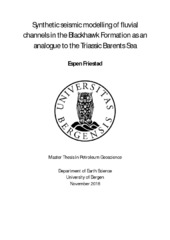Synthetic seismic modelling of fluvial channels in the Blackhawk Formation as an analogue to the Triassic Barents Sea
Master thesis
Permanent lenke
https://hdl.handle.net/1956/18752Utgivelsesdato
2018-12-08Metadata
Vis full innførselSamlinger
- Department of Earth Science [1034]
Sammendrag
Seismic modelling studies based on field analogues is a promising tool to close the gap between observations in field and interpretations of seismic data. Fluvial channel deposits can be great reservoirs for hydrocarbons, water and CO2-storage in the subsurface. However, there are considerable uncertainties on how size, geometries and architecture of such deposits are resolved in subsurface seismic. By seismic modelling outcrops of fluvial channel deposits that have such variation in size, geometry and architecture, the resulting synthetic seismic data can be analysed and used to better understand subsurface fluvial reservoirs. To increase knowledge about seismic imaging of fluvial deposits, I will present different synthetic seismograms from non-marine deposits in the Blackhawk Formation from a seismic-scale (250 m x 5.3 km) outcrop in Book Cliffs (Utah, USA). The study highlights what impact the dominant frequency has on the detail-level for such deposits in seismic data. In comparison with actual seismic data from the Triassic Barents Sea, synthetic seismic data with equivalent frequency show several similarities in detail. Furthermore, the process of analogue seismic modelling is evaluated, where the input from a high-detailed (down to 14 cm) outcrop-mapping shows a difference of up to 36 % in seismic amplitude compared to more conventional and simplified input-modelling. A survey in seismic interpretation of fluvial deposits was conducted using the generated seismograms, where nine participants that are geologists with different levels of experience, were asked to map out fluvial deposits at different resolutions. This gives an objective view of how the different synthetic seismograms would be interpreted by unbiased interpreters, where the results show that high-resolution seismic are interpreted in more detail but still have large uncertainties. By improving the understanding of fluvial deposits at different resolution-levels, it is possible to make seismic interpretations that are closer to the real stratigraphy.
